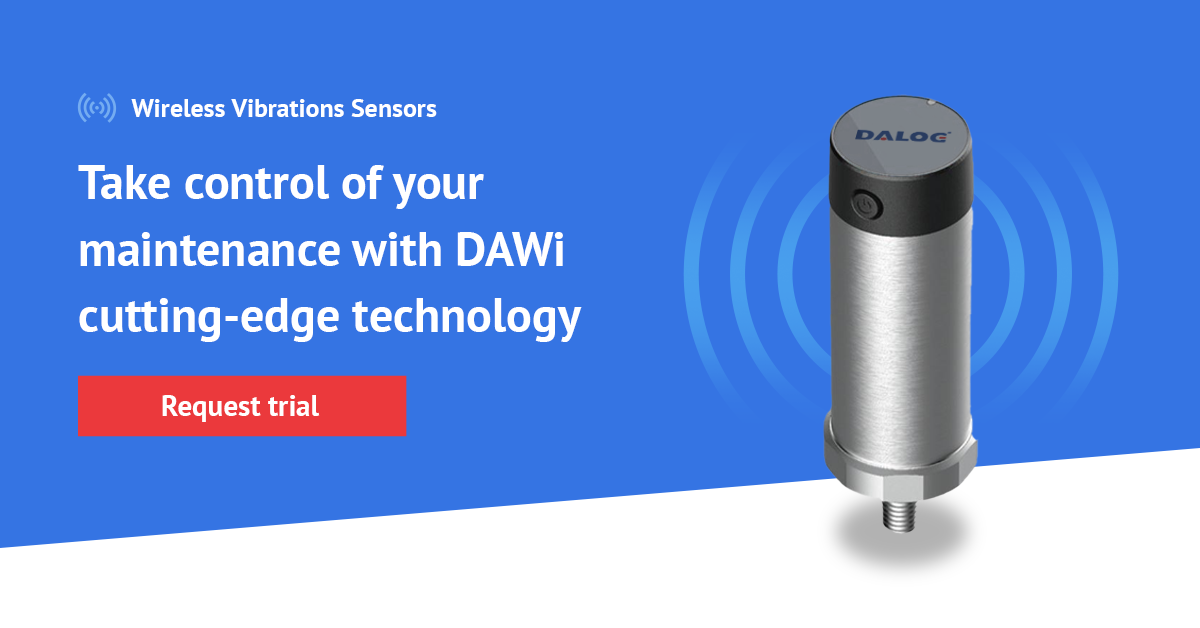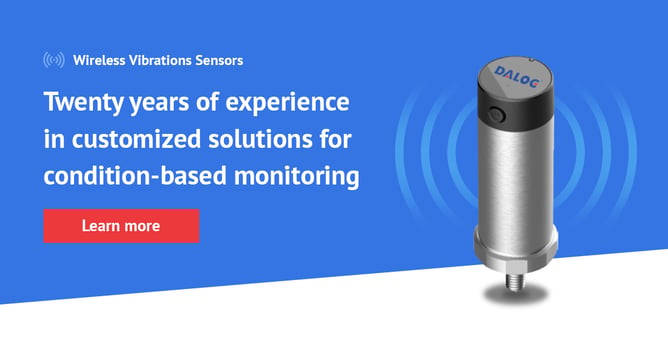The Advantages of Wireless Sensors in Predictive Maintenance Programs
Companies constantly look for ways to improve efficiency, reduce downtime, and stay ahead of potential problems in today's fast-paced manufacturing world. Predictive maintenance is one of the most effective ways to achieve these goals.
This involves monitoring equipment to predict when it will fail, which can be done using various tools, including wireless sensors. In this article, we will examine the advantages of predictive maintenance programs and the benefits of using wireless sensors in these programs.
Learn more about wireless sensors, predictive maintenance programs, and what advantages they could bring to your company:
- What are Wireless Sensors?
- What is a Predictive Maintenance Program?
- Advantages of a Predictive Maintenance Program
- Advantages of Wireless Sensors in Predictive Maintenance Programs
- Real-life examples of Wireless Sensors in Predictive Maintenance Programs
What Are Wireless Sensors?
Wireless sensors are small, battery-operated devices that collect and transmit data wirelessly to a central system. They are designed to be placed on or near equipment, machinery, or other assets and monitor various parameters, including temperature, vibration, pressure, and more.
Unlike traditional wired sensors, wireless sensors do not require any physical connection to the monitored equipment, making them much easier to install and use. They can be installed without hardwiring or specialized installation teams and can be monitored remotely, reducing the need for on-site visits.
Wireless sensors have various applications, including predictive maintenance, environmental monitoring, and industrial automation. In predictive maintenance programs, wireless sensors are used to monitor the performance of equipment and machinery and provide real-time data that can be used to predict when maintenance will be needed. By identifying potential issues before they become critical, companies can schedule maintenance activities cost-effectively and reduce unexpected downtime.
What Is a Predictive Maintenance Program?
A predictive maintenance program is a system for monitoring equipment to predict when it will fail. Predictive maintenance aims to reduce downtime by detecting potential problems before they become serious.
Predictive maintenance uses various tools, including wireless sensors, predictive software, and specialized equipment. Predictive maintenance programs have become increasingly important in modern manufacturing as they help companies stay ahead of potential problems and avoid costly repairs and unscheduled downtime.
An example of a predictive maintenance program can be seen in monitoring critical machinery in a manufacturing plant. Wireless sensors can be placed on the machinery to scan for any signs of wear and tear, such as vibration or temperature fluctuations. This information is transmitted wirelessly to a central monitoring system, where predictive software can analyze the data to predict when the machinery will fail.
This enables plant managers to schedule maintenance and repairs during scheduled downtime, reducing the risk of unexpected downtime and saving money in the long run.
Advantages of a Predictive Maintenance Program
There are many benefits to implementing a predictive maintenance program, including reduced downtime, improved efficiency, and increased safety. By detecting potential problems before they become serious, companies can avoid costly repairs and unscheduled downtime.
Predictive maintenance can also improve efficiency by enabling engineers to make informed decisions based on real-time data. Additionally, predictive maintenance can improve safety by reducing the risk of accidents.
For example, a predictive maintenance program can be implemented in a large commercial building to monitor the HVAC system. Wireless sensors can be placed on the HVAC system to monitor for any signs of wear and tear, such as temperature fluctuations or unusual vibration levels. This information can be transmitted wirelessly to a central monitoring system, where predictive software can analyze the data to predict when the HVAC system is likely to fail. This enables building managers to schedule maintenance and repairs during scheduled downtime, reducing the risk of unexpected downtime and improving the overall comfort and safety of the building's occupants.
Download and learn more about predictive maintenance from The Reliability Manager's Plan: How to Choose the Most Cost-Effective Solution for Predictive Maintenance
Advantages of Wireless Sensors in Predictive Maintenance Programs
The use of wireless sensors in predictive maintenance programs has become increasingly popular in recent years due to the many benefits they offer. Some of the key advantages of wireless sensors include the following:
Increased Flexibility: They can be easily relocated or repositioned to accommodate equipment changes without additional costs. This makes wireless sensors ideal for monitoring equipment in remote or hard-to-reach locations. For example, a mining company may use wireless sensors to monitor the performance of its heavy machinery and move the sensors to new machines as they are added to the fleet.
Improved Data Quality: This leads to more accurate predictions and better maintenance planning. For example, a power plant using wireless sensors to monitor its boilers and turbines can detect small temperature or pressure changes and adjust its operations accordingly, reducing the risk of unplanned downtime.
Reduced Maintenance Costs: Wireless sensors do not require a high level of maintenance, as they do not have any wiring that can become damaged over time. This results in reduced maintenance costs and a longer lifespan for the sensors. For example, a transportation company using wireless sensors to monitor the performance of its fleet of trucks can schedule maintenance activities during off-peak times, reducing the impact on its operations and saving on maintenance costs.
Remote Monitoring: Wireless sensors can be monitored remotely, reducing the need for on-site visits and allowing companies to monitor their equipment from anywhere. This saves time and improves efficiency, as maintenance teams can respond to any issues quickly and effectively. For example, a cement company using wireless sensors to monitor its kilns and conveyor belts can react promptly to problems, even if the equipment is located in a remote quarry, reducing the risk of unplanned downtime.
Improved Maintenance Planning: Wireless sensors can provide accurate and detailed information about equipment performance, enabling companies to plan their maintenance activities more effectively. This can help companies avoid unexpected downtime and improve overall efficiency. For example, a plastics manufacturer using wireless sensors to monitor its injection molding machines can create a more accurate maintenance plan based on real-time data, reducing the risk of unplanned downtime and improving efficiency.
Increased Agility: Wireless sensors can be quickly deployed, reducing the time needed to get predictive maintenance programs up and running. This enables companies to respond rapidly to changes in their equipment and adapt to new challenges, improving overall efficiency and performance. For example, a metallurgical company using wireless sensors to monitor its furnaces can quickly adjust its operations based on real-time data, reducing the risk of unplanned downtime and improving efficiency.
Scalability: Wireless sensors can be added or removed from a predictive maintenance program, allowing companies to scale their monitoring capabilities up or down as required. This enables companies to effectively manage costs and allocate resources where they are needed most. For example, a company using wireless sensors to monitor its equipment can add more sensors as needed, making it easy to expand its monitoring and maintenance activities to new assets and locations.
Enhanced Safety: Wireless sensors can monitor equipment for hazardous conditions, such as high temperatures or excessive vibration. This enables companies to address potential safety issues before they become a problem proactively. For example, wireless sensors can be placed on heavy machinery to monitor excessive vibration levels that could indicate a malfunction, allowing operators to take the necessary steps to address the issue before it leads to an equipment failure.
Improved Equipment Life: By using wireless sensors to monitor for signs of wear and tear on equipment, companies can extend the life of their equipment. For example, wireless sensors can be placed on industrial pumps to monitor for changes in vibration levels or temperature fluctuations, allowing operators to identify any potential issues before they lead to equipment failure.
Improved Energy Efficiency: Wireless sensors can monitor energy usage and identify areas where improvements can be made. For example, wireless sensors can be placed in data centers to monitor energy usage, allowing operators to identify areas where energy efficiency can be improved, such as by implementing more efficient cooling systems.
Better Inventory Management: Wireless sensors can be used to track inventory levels and improve the efficiency of supply chain operations. For example, wireless sensors can be placed on pallets of goods to monitor their location and condition in real-time, allowing companies to manage their inventory and reduce waste more effectively.
Enhanced Asset Management: Wireless sensors can monitor the performance and maintenance of assets in real-time, allowing companies to identify areas for improvement and optimize their maintenance programs. For example, wireless sensors can be placed on vehicles to monitor fuel consumption, tire wear, and other factors, enabling fleet managers to make informed decisions about when to schedule maintenance and repairs, improving overall fleet performance and reducing downtime.
Real-Time Monitoring: Wireless sensors can provide real-time equipment monitoring, enabling companies to respond quickly to any issues. For example, wireless sensors can be placed on heavy machinery to monitor excessive vibration levels that could indicate a malfunction, allowing operators to take the necessary steps to address the issue before it leads to an equipment failure.
Environmental Benefits: Wireless sensors can monitor the environment and identify areas where improvements can be made. For example, wireless sensors can be placed in manufacturing facilities to monitor emissions levels, enabling companies to identify areas where they can reduce their environmental impact.
Real-life Examples of Wireless Sensors in Predictive Maintenance Programs
The use of wireless sensors in predictive maintenance programs has revolutionized how companies approach equipment maintenance and optimization. Wireless sensors help companies improve operations and increase profitability by providing real-time monitoring and data.
Let's explore several real-life examples of how companies across different industries leverage wireless sensors' benefits in their predictive maintenance programs.
These examples will provide a comprehensive understanding of wireless sensors' impact on a company's bottom line, from mining and cement to power plants and transportation.
Whether you're a maintenance manager, a reliability manager, or a plant director, these real-life examples will give you a glimpse into the world of wireless sensors and predictive maintenance and demonstrate how these cutting-edge technologies transform companies' operations.
Mining: A mining company can use wireless sensors to monitor the performance of its heavy equipment. By tracking the equipment's vibration and temperature, they could predict when maintenance will be needed and reduce unexpected downtime. This helps to improve their production efficiency and increase profitability.
Cement: A cement company could implement a wireless sensor network to monitor the performance of their kilns. The sensors provide real-time data on temperature, pressure, and other parameters, allowing the company to optimize its production processes and reduce energy consumption.
Metallurgy: A steel manufacturer can use wireless sensors to monitor the performance of their furnaces. By tracking temperature, pressure, and other parameters, they could identify areas for improvement and optimize their operations. This helps them increase production efficiency and reduce downtime.
Power Plants: A power plant could utilize wireless sensors to monitor the performance of its turbines and generators. The sensors would provide real-time temperature, pressure, and vibration data, enabling the power plant to schedule maintenance activities cost-effectively and reduce unexpected downtime.
Plastics: A plastics manufacturer could use wireless sensors to monitor the performance of their production line. The sensors would provide real-time production rates and machine efficiency data, allowing the company to identify bottlenecks and optimize its operations. This helps to increase production efficiency and reduce costs.
Transportation: A transportation company could use wireless sensors to monitor the performance of its fleet of vehicles. The sensors would provide real-time data on fuel consumption, speed, and other parameters, allowing the company to optimize its routes and reduce fuel costs.
Predictive maintenance programs and wireless sensors are essential to modern manufacturing. They help companies reduce downtime, improve efficiency, and increase safety.
Wireless sensors provide many advantages, including ease of installation and maintenance, remote monitoring capabilities, and improved accuracy.
Companies can avoid potential problems, reduce downtime, and improve overall performance by taking advantage of the benefits of predictive maintenance and wireless sensors.
Download and learn more about wireless sensors and predictive maintenance from The Reliability Manager's Plan: How to Choose the Most Cost-Effective Solution for Predictive Maintenance.
Interested in a Wireless Vibration Solution for your company? Learn more about DAWi, our wireless vibration sensor.








